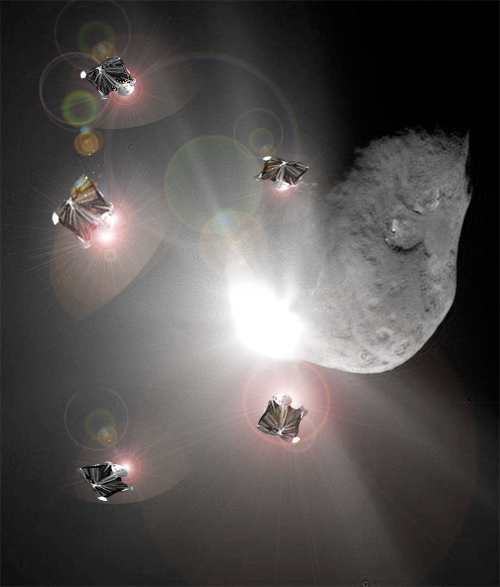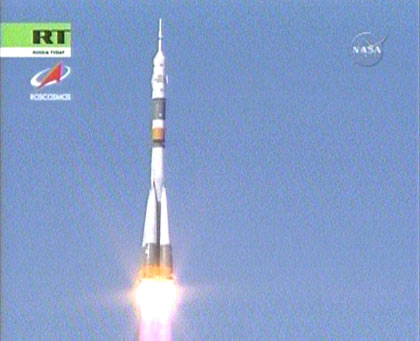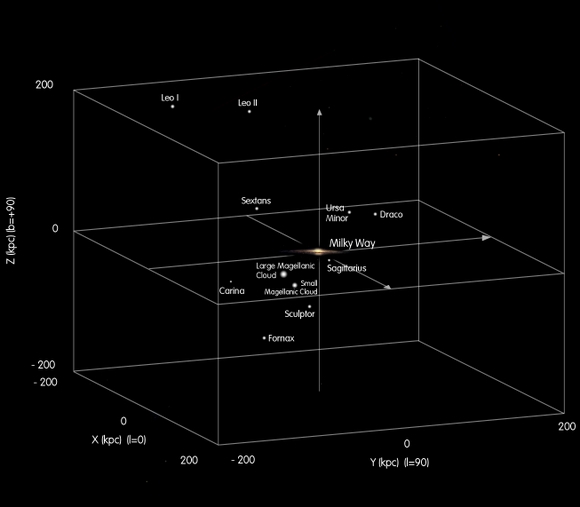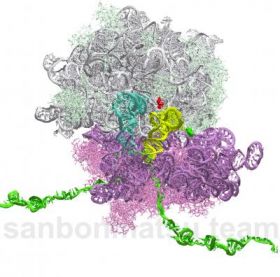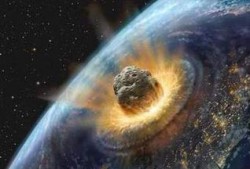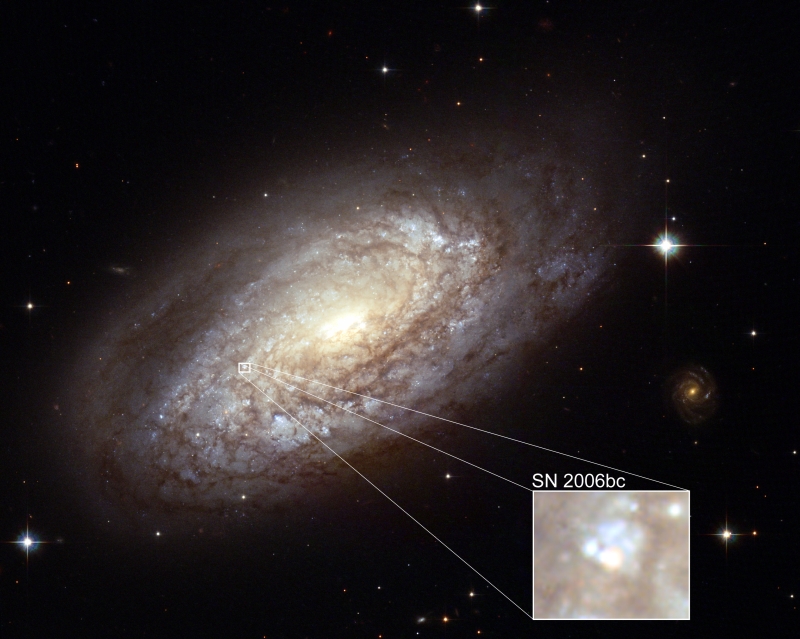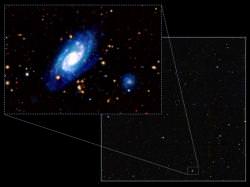Here are some additional resources we’ve put together.
Help Move An Asteroid and Other Space-Related Opportunities
If you’ve got some ideas about how to deflect an asteroid or comet heading towards Earth, there’s an opportunity out there to have your concept reviewed by some of the world’s top astronomers and physicists. The only restriction is that you must be a student or a young professional under the age of 33. This announcement comes on the heels of notices of other opportunities for young people to get involved with space missions. The space sector must be listening to recent complaints that the younger generation feels a disconnect to space-related activities. At any rate, these are great opportunities.
Here’s more on the asteroid competition, as well as more ways for students to get involved with space missions:
The “Move An Asteroid 2008†competition is sponsored by the Space Generation Advisory Council. It’s an international technical paper competition looking for unique and innovative concepts for how to deflect an asteroid or comet that may impact the Earth. The competition is open to individuals or teams, and they must write and submit a 3-10 page original technical paper on their innovative concept. The 1st place award is a trip to present the winning paper at this year’s Space Generation Congress (SGC) and International Astronautical Congress (IAC) which take place in Glasgow, Scotland from late September until early October 2008. The 2nd place award is a trip to present at the SGC. Entries are due on June 9, 2008 and winners will be announced on June 30, 2008, the 100th anniversary of the Tunguska Event, the largest asteroid/comet impact event in Earth’s recent history.
Another opportunity is the Cassini Scientist for a Day contest. The contest is open to all students in the U.S. between grades 5 and 12, working alone or in groups of up to four students. This is a competition for the privilege of deciding where to point the cameras onboard the Cassini spacecraft on June 10, 2008. There will be 55 minutes of time where the winners will control of spacecraft, plenty of time to turn it as needed and point the cameras at pretty much any target you’d like. In case you’re not sure what targets would be best, the Cassini team has narrowed the field of possible targets. Deadline for submission is Noon, Pacific Daylight Time on May 8, 2008 (3:00 p.m. Eastern time).
Next, there’s the NASA Quest LIMA Challenge for Students in Grades 4-8. In this challenge, students become scientists and propose Antarctic research. The Landsat Image Mosaic of Antarctica is the first true-color high-resolution satellite view of the Antarctic continent. Using this view of Antarctica, students must develop a research question and debate the value of studying the chosen feature. Registration is currently open and educational resources are available online. This is going on right now, with the deadline for preliminary proposals due on April 20, 2008, so check this one out soon.
Also, there’s a chance for U.S. students to involved working with the mission operations associated with the Mars Reconnaissance Orbiter and specificially the CRISM (Compact Reconnaissance Imaging Spectrometer for Mars) on board MRO, currently orbiting Mars. The project is called Mars Exploration Student Data Teams. This is an ongoing program for high school students, and one adult facilitator is required. This program is facilitated through a cooperative effort by NASA and Arizona State University. Another similar program is the Mars Student Imaging Project that works with the Mars Odyssey orbiter. You can find more info on that program here.
Also ongoing is the ISS EarthKAM (Earth Knowledge Acquired by Middle school students)program, a NASA education program which gives students teachers the chance to choose targets on Earth for pictures to be taken from the International Space Station. Learn more about that program here.
Original News Source: Space Generation Advisory Council
Intel to Protect Microchips from Cosmic Rays

As computers become more advanced, the microprocessors inside them shrink in size and use less electrical current. These new, energy efficient chips can be crammed closer together, increasing the number of calculations that can be done per second, therefore making the computer more powerful. But even the mighty supercomputer has its Achilles heel: an increased sensitivity to interference from charged particles originating beyond your office. These highly energetic particles come from space and may cause critical hardware to miscalculate, possibly putting lives at risk.
Foreseeing this problem, microchip manufacturer Intel has begun devising ways to detect when a shower of charged particles may hit their chips, so when they do, calculations can be re-run to iron out any errors…
Cosmic rays originate from our Sun, supernovae and other unknown cosmic sources. Typically, they are very energetic protons that zip through space close to the speed of light. They could be so powerful that on impact with the upper atmosphere of the Earth it has been postulated that they may create micro black holes. Naturally these energetic particles can cause some damage. In fact, they may be a huge barrier to travelling beyond the safety of Earth’s magnetic field (the magnetosphere deflects most cosmic radiation, even astronauts in Earth orbit are well shielded), the health of astronauts will be severely damaged during prolonged interplanetary flight.
But what about on Earth, where we are protected from the full force of cosmic rays? Although a small portion of our annual radiation dose comes from cosmic rays (roughly 13%), they can have extensive effects over large volumes of the atmosphere. As cosmic rays collide with atmospheric molecules, a cascade of light particles is produced. This is known as an “air shower”. The billions of particles within the air shower from a single impact are often highly charged themselves (but of lesser energy than the parent cosmic ray), but the physics behind the air shower is beginning to grow in importance, especially in the realms of computing.
It seems computer microprocessor manufacturer Intel has been pondering the same question. They have just released a patent detailing their plans should a cosmic ray penetrate the atmosphere and hit one of their delicate microchips. The problem will come when computing becomes so advanced that the tiny chips may “misfire” when a comic ray impact event occurs. Should the unlucky chip be hit by a cosmic ray, a spike of electrical current may be exerted across the circuitry, causing a miscalculation.
This may sound pretty benign; after all, what’s one miscalculation in billions? Intel’s senior scientist Eric Hannah explains:
“All our logic is based on charge, so it gets interference. […] You could be going down the autobahn [German freeway] at 200 miles an hour and suddenly discover your anti-lock braking system doesn’t work because it had a cosmic ray event.” – Eric Hannah.
After all, computers are getting smaller and cheaper, they are being used everywhere including critical systems like the braking system described by Hannah above. As they are so small, many more chips can occupy computers, increasing the risk. Where a basic, one processor computer may only experience one cosmic ray event in several years (producing an unnoticed calculation error), supercomputers with tens of thousands of processors may suffer 10-20 cosmic ray events per week. What’s more, in the near future even humble personal laptops may have the computing power of today’s supercomputer; 10-20 calculation errors per week would be unworkable, there would be too high a risk of data loss, software corruption or hardware failure.
Orbital space stations, satellites and interplanetary spacecraft also come to mind. Space technology embraces advanced computing as you get far more processing power in a smaller package, reducing weight, size and cost. What happens when a calculation error occurs when a cosmic ray hits a satellite’s circuitry? A single miscalculation could spell the satellite’s fate. I’d dread to think what could happen to future manned missions to the Moon, Mars and beyond.
It is hoped that Intel’s plan may be the answer to this ominous problem. They want to manufacture a cosmic ray event tracker that would detect a cosmic ray impact, and then instruct the processor to recalculate the previous calculations from the point before the cosmic ray struck. This way the error can be purged from the system before it becomes a problem.
There will of course be many technical difficulties to overcome before a fast detector is developed; in fact Eric Hannah admits that it will be hard to say when such a device may become a practical reality. Regardless, the problem has been identified and scientists are working on a solution, at least it’s a start…
Source: BBC
Soyuz Launches With South Korea’s First Astronaut
South Korea’s first astronaut and two Russian cosmonauts blasted off from the Baikonur Cosmodrome in Kazakhstan today and are on their way to the International Space Station. So-Yeon Yi, a 29-year-old female engineer joined incoming Expedition 17 commander Sergei Volkov and flight engineer Oleg Kononenko in the three-seat Soyuz TMA-12 spacecraft, which lifted off at 7:16:39 a.m. EDT. Besides conducting some scientific research Yi has said she will sing to her crewmates and prepare some Korean cuisine for them as well.
Yi, the youngest woman to ever launch into space, is flying under a commercial agreement between the Russian space agency and South Korea’s ministry of science and technology. The Soyuz will catch up with the ISS in two days, and dock at the Pirs airlock module around 9:00 a.m. on Thursday, April 10.
Yi will spend nine days aboard the space station and return to Earth on April 19 with outgoing Expedition 16 commander Peggy Whitson and flight engineer Yuri Malenchenko, currently on board the ISS. The other astronaut on the space station, and the third member of the Expedition 16 crew, NASA astronaut Garrett Reisman, will remain aboard the lab complex with Volkov and Kononenko and become a member of Expedition 17. Reisman came to the station aboard the shuttle Endeavour in March. He will be relieved in early June by astronaut Gregory Chamitoff, scheduled to launch May 31 aboard the shuttle Discovery.
Volkov, 35, is the son of cosmonaut Alexander Volkov and is the first second-generation cosmonaut or astronaut to fly in space. The elder Volkov spent one expedition on board the Soviet Salyut space station (Salyut 7 in 1985, for 65 days) and two stay on board the Mir space station (Mir 4 in 1988 for 152 days and Mir 10 in 1991 for 175 days.)
In video shown during the Soyuz’ climb to space, Yi, seated to Volkov’s right, could be seen enthusiastically waving a thumbs up at the camera and smiling.
Original News Sources: NASA, NASA TV
A Case of MOND Over Dark Matter
According to Newton’s Second Law of Dynamics, objects on the farthest edges of galaxies should have lower velocities than objects near the center. But observations confirm that galaxies rotate with a uniform velocity. Some astronomers believe the orbital behavior of galaxies can be explained more accurately with Modified Newtonian Dynamics (MOND) — a modified version of Newton’s Second Law — than by the rival, but more widely accepted, theory of dark matter. The dark matter theory assumes that a halo of dark matter surrounds each galaxy, providing enough matter (and gravity) that all the stars in a galaxy disc orbit with the same velocity. MOND, however uses a different explanation, and a recent study of eight dwarf galaxies that orbit the Milky Way seems to favor the MOND approach over the dark matter theory.
“MOND was first suggested to account for things that we see in the distant universe,†said Garry Angus, of the University of St Andrews. “This is the first detailed study in which we’ve been able to test out the theory on something close to home. The MOND calculations and the observations appear to agree amazingly well.”
Usually the equation F=ma (force = mass X acceleration) solves your basic acceleration problems. But it doesn’t explain the observed rotation of galaxies. MOND suggests that at low values of acceleration, the acceleration of a particle is not linearly proportional to the force. According to Angus, MOND adds a new constant of nature (a0) to physics, besides the speed of light and Planck’s constant. Above the constant, accelerations are exactly as predicted by Newton’s second law (F=ma). Below it, gravity decays with distance from a mass, rather than distance squared. This constant is so small that it goes unnoticed with the large accelerations that we experience in everyday life. For instance, when we drop a ball the gravity is 100 billion times stronger than a0 and the accelerated motion of the Earth round the Sun is 50 million times stronger. However, when objects are accelerating extremely slowly, as we observe in galaxies or clusters of galaxies, then the constant makes a significant difference to the resulting gravitational forces.
When MOND is applied to nearby dwarf galaxies, one effect is that tidal forces from the Milky Way, which have a negligible effect in classical Newtonian Mechanics, can actually make a big difference. This is particularly significant for the dwarfs orbiting close to our Galaxy.
“In these dwarf galaxies, the internal gravity is very weak compared to the gravity of the Milky Way,” said Angus. “MOND suggests that the Milky Way is a bit like a bank that loans out gravity to nearby dwarf galaxies to make them more stable. However, there are conditions on the loan: if the dwarf galaxies start to approach the bank, the loan is gradually reduced or even cancelled and the dwarfs must pay it back. In two galaxies, we’ve seen what could be signs that they’ve come too close too quickly and are unable to repay the loan fast enough. This appears to have caused disruption to their equilibrium.”
Angus used MOND to calculate the ratio of mass to amount of light emitted by the stars in the dwarf galaxies from the observed random velocities of the stars collected independently. He also calculated the orbital paths of the stars in the dwarf galaxies. In all eight cases, the MOND calculations for the orbits were within predictions. For six of the eight galaxies, the calculations were also a good match to expected values for mass-to-light ratios; however for two galaxies, Sextans and Draco, the ratios were very high, which could well suggest tidal effects. The value for Sextans could also be due to poor quality measurements of the galaxy’s luminosity, which Angus said are improving all the time for these ultra dim objects.
“These tidal effects can be tested by updating the 13 year old luminosity of Sextans and making accurate observations of the orbits of Draco and Sextans around the Milky Way. We also need to carry out some detailed simulations to understand the exact mechanisms of the tidal heating,” said Angus.
If Newton’s gravity holds true, the dark matter needed in the dwarf galaxies has constant density in the center which is contrary to theoretical predictions, which suggest density should rise to the center.
“Even without direct detection, the dark matter theory is difficult to prove or refute and although we may not be able to prove whether MOND is correct, by carrying out these kind of tests we can see if it continues to hold up or if it is definitely ruled out,” said Angus.
Original News Source: Royal Astronomy Society’s National Astronomy Meeting
SkyWatcher Alert: Pleiades Occultation on April 8
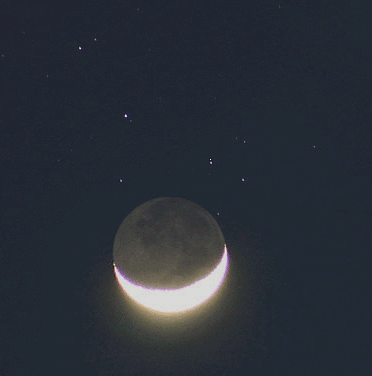 Sure. For those of us who hang around the night sky, we know the Pleiades and the Moon frequently venture near each other during the course of a year, but it’s much less common for the Moon to be in a crescent phase when they visit. Because the light of the nearby Moon often overpowers the cool, blue star cluster M45, SkyWatchers rarely have the opportunity to see the Moon sedately cover its stars. Not this time… Continue reading “SkyWatcher Alert: Pleiades Occultation on April 8”
Sure. For those of us who hang around the night sky, we know the Pleiades and the Moon frequently venture near each other during the course of a year, but it’s much less common for the Moon to be in a crescent phase when they visit. Because the light of the nearby Moon often overpowers the cool, blue star cluster M45, SkyWatchers rarely have the opportunity to see the Moon sedately cover its stars. Not this time… Continue reading “SkyWatcher Alert: Pleiades Occultation on April 8”
Meteorites Make a Big Splash on Mars: New Images of Secondary Craters by HiRISE
They look like pockmarks caused by shrapnel from a huge explosion. Actually they are surface features on Mars as seen by the High Resolution Imaging Science Experiment (HiRISE) on board the Mars Reconnaissance Orbiter (MRO). But what are they? They’re not potholes formed by geological processes, they’re not openings to ancient lava tubes, they are impact craters… but not like any impact crater you’ve seen before…

Most meteorite impact craters are roughly circular. If they are fairly new, ejected debris will be obvious emanating from the impact site. However, recent images by the HiRISE instrument appear to show tiny impact craters, in a swarm, each looking like they have been chiselled roughly out of the Martian regolith (pictured left).
The area of the image covers roughly 0.5×1.5 kilometres (25cm/pixel; features down 85cm can be resolved) of a large outflow channel in the Chryse Planitia region. The craters are actually secondary impact craters caused by large chunks of Martian rock being thrown up into the air after an energetic impact from a meteorite. To give an idea of size, the largest craters are about 40 meters across, a little smaller than an Olympic-sized swimming pool. It is not clear where the primary impact crater is in relation to the debris craters in the full-resolution image.
There appears to be dark material inside these small craters, possibly from the debris digging into layered deposits of different minerals just below the surface. Ripples of sand and dust are also evident. As these small craters are quite shallow, they will fill up and level out with wind-blown material quickly, so these secondary craters are fairly young when compared with geological timescales.
Source: HiRISE mission site
Did a Cooked Meteorite Seed Life on Earth?
Earth, four billion years ago, was a lifeless, hot and violent place. Not exactly a world where you’d expect life to form. But this was the scene where the first life-forming amino acids appeared. And how did this happen? According to new research, a lump of rock floating though space may have been irradiated by neutron star emissions, chemically altering amino acids hitching a ride on it. This rock then impacted the Earth and injected these altered chemicals into the desert wastes, possibly seeding the beginning of life on our planet… and this life was left-handed…
We’ve heard about this possibility before: life on Earth being seeded by some extra-terrestrial body, like a comet, meteorite or asteroid impact. In fact the prime reason for analysing comets and objects in the Oort Cloud (hovering around the outer reaches of our solar system) is to look for pre-life chemicals and organic compounds such as amino acids. Indeed, the discovery of organic compounds by the recent Cassini flyby of Saturn’s moon last month is another piece in the puzzle toward understanding the extent of life-giving chemicals on planets other than Earth.
Amino acids are a type of protein found in all life forms on Earth, it seems reasonable to search for the presence of these proteins on bodies other than our planet, possibly giving us more information about how life formed and where life came from.
There are two forms of amino acids, one left-handed and one right-handed, giving an indication of the orientation of the acid. For life to be seeded, these proteins must contain only one “chirality” (i.e. either left or right), it’s no good having mixed chirality.
At the 235th national meeting of the American Chemical Society, new research has been presented describing how our amino acid signature may have come from outer space. Ronald Breslow, a university professor at Columbia University points out that the vast majority of life on Earth has a “left chirality”. And his reason for this? The polarized light emitted from neutron stars many billions of years ago irradiated rocky bodies, with amino acid compounds on their surface, selectively destroying most of the “right-hand” acids. Although this theory may sound outlandish, it does give a possible reason for the prevalence of left-hand proteins in amino acids on Earth.
The irradiated meteorite will have impacted the Earth carrying amino acids with a dominance of left chirality which dropped into the “primordial soup”, evolving into the first forms of life. All life as we know it will have the same chirality as this soup of pre-biotic life.
“These meteorites were bringing in what I call the ‘seeds of chirality’ […] If you have a universe that was just the mirror image of the one we know about, then in fact, presumably it would have right-handed amino acids. That’s why I’m only half kidding when I say there is a guy on the other side of the universe with his heart on the right hand side.” – Ronald Breslow.
Breslow and his team simulated the events after such a meteorite hit the surface. As the left-hand dominated amino acids from space combined with existing amino acids (of mixed chirality) on Earth, the desert-like temperatures and a dash of water amplified the left-hand proteins, giving them dominance, thus sparking the basic building blocks of life. He argues that these acids were most likely brought to Earth via meteorite, and not chemically altered by radiation in-situ, “…the evidence that these materials are being formed out there and brought to us on meteorites is overwhelming,” said Breslow.
Source: Physorg.com
Supernova Precursor Discovered in Spiral Galaxy NGC 2397
It’s a bit like trying to find a needle in a haystack when looking for a star in a galaxy. Although hard to do, astronomers using images from the Hubble Space Telescope (HST) are doing just that, trying to find stars before they explode as supernovae. In 2006, supernova SN 2006bc was spotted in spiral galaxy NGC 2397, so astronomers got to work, sifting through previous images taken by the HST. They found that star, in the rising stage of brightness as it exploded. Usually we don’t get to see this stage of a supernova, as we can’t predict which star is going to blow. But retracing years of HST observational data, scientists are able to piece together the cosmic forensic evidence and see the star before it died…
SN 2006bc was seen in the spiral galaxy NGC 2397, located nearly 60 million light years from the Milky Way, back in 2006. There was no warning or any indication that that star was going to blow in that galaxy (after all, there’s a lot out there), but Hubble’s Advanced Camera for Surveys (ACS) captured the galaxy after it happened. So astronomers watched the afterglow of the event. While a lot of good science can be done by analysing the remnants of a supernova, wouldn’t it be great to see a star before it explodes? Perhaps then we can analyse the emissions from an unstable star before it dies…
Predicting cosmic events is no new thing, and much effort is being put into various forecasting techniques. A few examples include:
- Solar radiation: The main focus for solar physicists is to predict “space weather” to help protect us against the dangerous onslaught of high energy particles (particularly solar flares).
- Detecting supernova neutrinos: An “early warning” system is already in place to detect the neutrinos that are blasted from a star’s core at the moment of a star’s collapse (leading to a supernova). The SuperNova Early Warning System (SNEWS) has been set up to detect these neutrinos.
- Gamma ray bursts (GRBs): The Polish “Pi of the Sky” GRB detector is an array of cameras looking out for optical flashes (or transients) in the night sky above the Chilean mountains. Combined with NASA’s Swift gamma ray observatory in orbit, the burst is detected, immediately signalling other observatories to watch the event.
The above examples usually detect the sudden event of a solar flare, GRB or surge of neutrinos right at the point of initiation. Fortunately for solar physicists, we have a vast amount of high-spatial and high-temporal resolution data about our closest star. Should a flare be launched, we can “rewind the tape” and see the location of flare initiation and work out the conditions before the flare was launched. From this, we are able to be better informed and possibly predict where the next flare will be launched from. Supernova astronomers aren’t so lucky. The cosmos is a big place after all, only a tiny proportion of the night sky has been observed in any great detail, and the chances that the same region has been imaged more than once at high resolution are few and far between.
Although the chances are slim, researchers from Queen’s University Belfast in Northern Ireland, led by Professor Stephen J. Smartt used Hubble Space Telescope (HST) images to “rewind the tape” before supernova SN 2006bc occurred. By confining their search for “pre-supernova” stars in local galaxies, there was a better chance of studying galaxies that have been imaged at high resolution and imaged more than once in the past. SN 2006bc turned out to be the perfect candidate.
The group has done this before. Of the six precursor stars discovered to date, Smartt’s team found five of them. From their analysis, it is hoped that the characteristics of a star before it dies can be worked out as the conditions for a supernova to occur is poorly understood.
After ten years of surveying, the group presented their discoveries of supernova precursor stars at this year’s National Astronomy Meeting 2008 in Belfast, last week. It appears that stars with masses as low as seven times the size of our Sun can explode as supernovae. They go on to hypothesise that the massive stars may not explode as supernovae and may just die through collapse and form as a black hole. The emission from such an event may be too faint to observe and the most energetic supernovae may be restricted to the smaller stars.
However, six supernova precursor stars are not a large number to make any big conclusions quite yet, but it is a big step in the right direction to better understand the mechanisms at work in a star just about to explode…
Source: ESA
UK “Time Machine” Reveals The Formation Of Distant Galaxies
If you thought the Hubble Deep Field galaxy photo was the most incredible thing you’ve ever seen, wait until you lay eyes on the most sensitive infrared map of the distant Universe ever taken. Over the last three years, UK astronomers have compiled data from the United Kingdom Infrared Telescope (UKIRT) in Hawaii and their results are nothing less than astounding.
Today, Dr. Sebastien Foucaud from the University of Nottingham presented his first results to the April 4 National Astronomy Meeting of the Royal Astronomical Society. These results only form part of the Ultra-Deep Survey (UDS) – an image containing over 100,000 galaxies over an area four times the size of the full Moon – and a look into the formation of the most distant galaxies yet witnessed.
The 3.8-metre (12.5-foot) UK Infrared Telescope (UKIRT) became a time machine as the world’s largest telescope dedicated solely to infrared astronomy began its Deep Sky Survey in 2005. Even now, the UDS image is but only one element of a five-part project. Due to the constraints of the speed of light, these observations allow astronomers to literally look back 10 billion years in time. The images that UKIRT produces see our Universe in its distant infancy, and the formation galaxies which date to back where we believe expansion began. The image is so large and so deep that thousands of galaxies can be studied at these early epochs for the very first time. Through the technological advance of infrared imaging, astronomers can now peer even further back in time, since light from the most distant galaxies is shifted towards redder wavelengths as it travels through the expanding Universe.
“I would compare these observations to the ice cores drilled deep into the Antarctic,” said Dr. Foucaud. “Just as they allow us to peer back in time, our ultra-deep image allows us to look back and observe galaxies evolving at different stages in cosmic history, all the way back to just 1 billion years after the Big Bang”.
One of the goals of the project is to further scientific understanding about the time frame in which rare, massive galaxies formed in the distant Universe. It is a puzzle that has simply remained unsolved. Says Dr. Foucaud: “We see galaxies 10 times the mass of the Milky Way already in place at very early epochs. Now, for the first time, we are sampling a large enough volume of the distant Universe to be able to see them in sufficient numbers and really pin down when they were formed.”
The UKIDSS Ultra-Deep Survey will, in time, give us a complete census of galaxy formation in the infrared. So far over one hundred thousand galaxies have been detected and the final image will be 100 times larger than any equivalent survey to date. Determining precise distances to faint galaxies is very difficult, requiring long hours of spectroscopy. For the faintest objects in the UDS survey this is often impossible. Instead, by using optical and infrared colors, astronomers are very effectively able separate distant galaxies from those which are nearby, and further separate them into those which are forming stars and those which are not. UKIDSS aims to discover the nearest object to the Sun (outside the solar system) as well as some of the farthest known objects in the Universe.
Does the Ultra-Deep Sky Survey images shed light on the great cosmological mystery? Only time – and distance – will tell. Professor Andy Lawrence, Principle Investigator of UKIDSS from the University of Edinburgh, said “As we keep taking images over the next few years, we will see ever more distant galaxies.”

